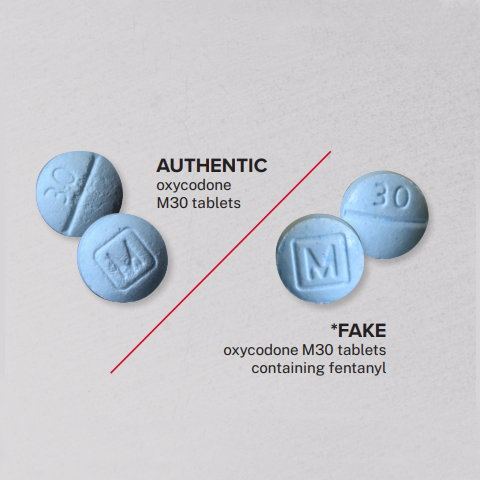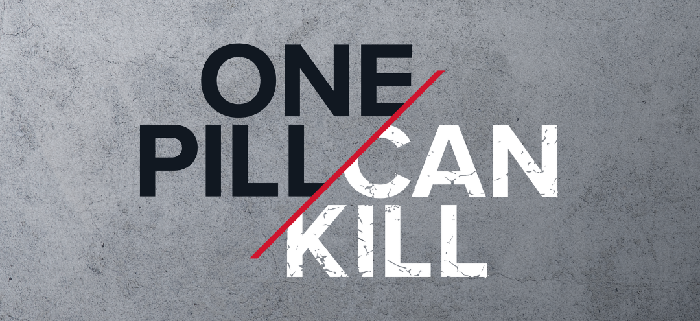Fentanyl is a synthetic opioid typically used to treat patients with chronic severe pain or severe pain following surgery. Fentanyl is a Schedule II controlled substance that is similar to morphine but about 100 times more potent. Under the supervision of a licensed medical professional, fentanyl has a legitimate medical use. Patients prescribed fentanyl should be monitored for potential misuse or abuse.
Illicit fentanyl, primarily manufactured in foreign clandestine labs and smuggled into the United States through Mexico, is being distributed across the country and sold on the illegal drug market. Fentanyl is being mixed in with other illicit drugs to increase the potency of the drug, sold as powders and nasal sprays, and increasingly pressed into pills made to look like legitimate prescription opioids. Because there is no official oversight or quality control, these counterfeit pills often contain lethal doses of fentanyl, with none of the promised drug.
Clandestinely-produced fentanyl is primarily manufactured in Mexico
 There is significant risk that illegal drugs have been intentionally contaminated with fentanyl. Because of its potency and low cost, drug dealers have been mixing fentanyl with other drugs including heroin, methamphetamine, and cocaine, increasing the likelihood of a fatal interaction.
There is significant risk that illegal drugs have been intentionally contaminated with fentanyl. Because of its potency and low cost, drug dealers have been mixing fentanyl with other drugs including heroin, methamphetamine, and cocaine, increasing the likelihood of a fatal interaction.
Producing illicit fentanyl is not an exact science. Two milligrams of fentanyl can be lethal depending on a person’s body size, tolerance and past usage. DEA analysis has found counterfeit pills ranging from .02 to 5.1 milligrams (more than twice the lethal dose) of fentanyl per tablet.
- 42% of pills tested for fentanyl contained at least 2 mg of fentanyl, considered a potentially lethal dose.
- Drug trafficking organizations typically distribute fentanyl by the kilogram. One kilogram of fentanyl has the potential to kill 500,000 people.
One Pill Can Kill
It is possible for someone to take a pill without knowing it contains fentanyl. It is also possible to take a pill knowing it contains fentanyl, but with no way of knowing if it contains a lethal dose.
According to the CDC, synthetic opioids (like fentanyl) are the primary driver of overdose deaths in the United States. Comparison between 12 months-ending January 31, 2020 and the 12 months-ending January 31, 2021 during this period:
- Overdose deaths involving opioids rose 38.1 percent.
- Overdose deaths involving synthetic opioids (primarily illicitly manufactured fentanyl) rose 55.6 percent and appear to be the primary driver of the increase in total drug overdose deaths.
Unless a drug is prescribed by a licensed medical professional and dispensed by a legitimate pharmacy, you can’t know if it’s fake or legitimate. And without laboratory testing, there’s no way to know the amount of fentanyl in an individual pill or how much may have been added to another drug. This is especially dangerous because of fentanyl’s potency.
How does fentanyl affect the body?
Fentanyl, similar to other commonly used opioid analgesics (e.g., morphine), produces effects such as:
- euphoria
- pain relief
- relaxation
- sedation
- confusion
- drowsiness
- dizziness
- nausea
- vomiting
- urinary retention
- pupillary constriction
In the U.S., 136 people die every day from an opioid overdose
Overdose may result in:
- stupor
- changes in pupillary size
- cold and clammy skin
- cyanosis – blue discoloration of the skin
- respiratory failure leading to death
- coma
DEA Resources:
2020 National Drug Threat Assessment
DEA Fentanyl Drug Factsheet
Fentanyl: The Next Wave of the Opioid Crisis
Fentanyl Flow to the United States
Narcotics
Fentanyl-Laced Crack Cocaine a Deadly New Threat
Drug Education and Prevention
The Overdose Crisis in the Washington D.C. Metro Area
Heroin and Opioid Awareness Campaign
DEA Fentanyl Related Press Releases
Department of Justice Fentanyl Related Press Releases
CDC Resources:
Opioid Overdose
Opioids
Provisional Drug Overdose Death Counts
Increase in Fatal Drug Overdoses Across the United States Driven by Synthetic Opioids Before and During the COVID-19 Pandemic
Trends and Geographic Patterns in Drug and Synthetic Opioid Overdose Deaths — United States, 2013–2019
Increases in Drug and Opioid-Involved Overdose Deaths — United States
Department of Health and Human Services
National Opioid Crisis
What are Opioids
A Patients Guide to Fentanyl – National Library of Medicine
National Institute on Drug Abuse Resources
Addressing America’s Fentanyl Crisis
Fentanyl – Drug Topics
The True Deadly Scope of America’s Fentanyl Problem
If you or someone you know has a mental health condition or a substance use disorder, there are resources and services available to assist with screening, treatment, and recovery:
SAMHSA’s National Helpline
1-800-662-HELP (4357)
TTY: 1-800-487-4889
Website:
www.samhsa.gov/find-help/national-helpline
www.https://www.findtreatment.gov
Also known as the Treatment Referral Routing Service, this Helpline provides 24-hour free and confidential treatment referral and information about mental health and substance use disorders, prevention, and recovery, in English and Spanish.
*The information and images above are a reprint/share from the DEA (United States Drug Enforcement Administration).


